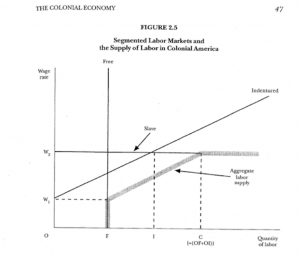Most students could recall the original thirteen colonies or recite the Declaration of Independence. However, few know what economic factors in colonial America led slavery to ultimately replace indentured servitude.
I enrolled in Econ 218, American Economic History this semester with Professor Lisa Nunn. This course uses economic models and theories to understand the path of economic development in the U.S. starting with colonization. Models are important in economics because they can be used to make assumptions or predictions. Models allow us to isolate certain parts of the economy and manipulate variables to see their outcomes.
In introductory economics, markets are modeled under the assumption of “ceteris paribus”, meaning all else held equal. In Econ 218, we analyze growth over time so this assumption no longer holds. I have found that this class helps me understand history better because I am learning the “why” to economic changes in the colonial era.
For example, in early colonial times slavery replaced the system of indentured servitude. Indentured servitude contracts were a device that “allowed people to pay for their passage to America by selling their labor to someone in the New World for a specified future period of time” (Walton and Rockoff 30). These were otherwise free men and women coming to America and serving out the period of their contract. Galenson estimates that “the average indenture for a twenty-year-old illiterate male with no occupation bound for Pennsylvania was fifty-six months” (Atack). This is roughly over 4 and a half years of work.
Figure 2.5 shows the labor supply in Colonial America. W1 is the lowest wage an indentured servant would accept. W2 is the supply of slave labor. Supply of labor is dismantled into three sources and the thicker, darker line is all three supply curves added together.
 Indentured servants, along with colonial workers, were a major factor in labor supply. However, they were gradually displaced by African slave labor. The answer to this question comes in several parts. The model for this situation is the labor market model with wage on the y axis and quantity of labor on the x as shown above. There are 3 supply curves on the graph. First, the supply of labor in the colonies which is perfectly inelastic because colonists were willing to work at any amount of wage to make money. Second, a perfectly elastic supply of African slaves because there was a fixed cost in securing and importing them. Finally, and a linear sloping supply curve of indentured servants because as wages rose, more indentured servants were willing to leave their country and come to America.
Indentured servants, along with colonial workers, were a major factor in labor supply. However, they were gradually displaced by African slave labor. The answer to this question comes in several parts. The model for this situation is the labor market model with wage on the y axis and quantity of labor on the x as shown above. There are 3 supply curves on the graph. First, the supply of labor in the colonies which is perfectly inelastic because colonists were willing to work at any amount of wage to make money. Second, a perfectly elastic supply of African slaves because there was a fixed cost in securing and importing them. Finally, and a linear sloping supply curve of indentured servants because as wages rose, more indentured servants were willing to leave their country and come to America.
In this model, simplifying assumptions are made to make it easier to answer the question. In reality, the supply for free laborers isn’t perfectly inelastic but it helps understand the model better.
Two economic factors caused the supply of indentured servants to shift left. First, income was rising in Britain. The opportunity cost for indentured servants coming to America rose. As income rose in Britain and the colonies, citizens who wished to come to America could pay their own way over. Further, the indentured servants required higher wages to proceed with the contract because they could make just as much money in Britain. This caused their supply curve to shift left.
Second, transportation costs lowered. Indentured servants coming to America didn’t have to work as long and could pay off their contract quicker. Indentured servants solved the problem of labor scarcity in the short run but once their contracts were up, they were free to be landowners and funneled out. With the increase in demand for workers rising, their wages were higher. This meant less years of service and their contract terms shortened. The supply curve for indentured servants shift left again. With lower transportation cost, the cost of shipping slave labor lowered and the supply shifted right. African slaves became more appealing to property owners because there was no contract, and they were bound to the land.
Overall, it’s important in economics to recognize that there is often more than one factor that leads to an outcome and we aren’t always able to observe “ceteris paribus” in the real world. Economic models are a way to observe and manipulate a certain area of the market. Indentured servants solved the problems of labor scarcity in the short run, but were eventually displaced by African slave labor. It is worthy to note that these changes set the stage for southern dependence on slave labor which will lead to the civil war.
The link above shows the final shifts where the supply of labor now consists solely of free labor and slave labor
